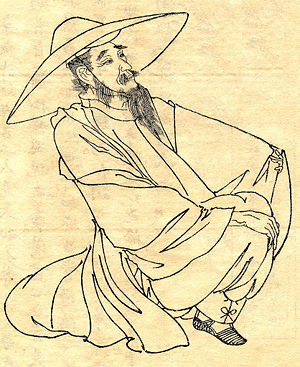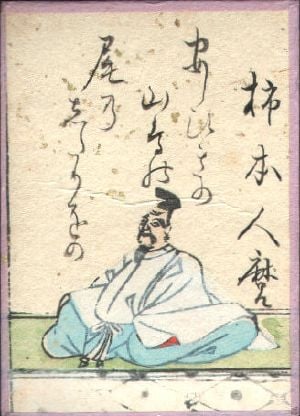Kakinomoto Hitomaro
Kakinomoto no Hitomaro (柿本 人麻呂; c. 662 - 710) was a Japanese poet of the Nara period. He was the most prominent of the Man'yōshū poets, in particular its volumes 1 and 2.
Works and Fame
Hitomaro's famed poems included "In the sea of ivy clothed Iwami"[1], "The Bay of Tsunu"[2], and "I loved her like the leaves". He has 19 chōka (or nagauta, 'long poems') in the Man'yōshū and 75 or so tanka (or mijikauta, 'short poems'). Many of his poems were written for public occasions, for instance, his "Lament for Prince Takechi". Other poems were written on occasions in his life when he was particularly moved: parting from his wife, mourning for his wife, or seeing a corpse.
In the Preface of the Kokin-wakashu compilation, Ki no Tsurayuki called him Uta no Hijiri, a divine poet of equal to Yamato-era poet Yamabe no Akahito. Ikeda Munemasa wrote "Portrait of Hitomaro and His Waka Poem". The modern waka poets like Masaoka Shiki and Saito Mokichi considered him one of greatest poets in the history of Japanese literature.
In Akashi, Hyogo Prefecture there is Kakinomoto Jinja, a shrine devoted to Hitomaro. The shrine holds every year an utakai (waka party) devoted to him.
In the Heian period, some anonymous waka in the Manyoshu was attributed to Hitomaro. These include the waka attributed to Hitomaro in Fujiwara no Teika's compilation of the Hyakunin Isshu.
Life
His life is uncertain despite his prominence as a poet. His name doesn't appear in Nihon Shoki nor in Shoku Nihongi (History of Japan II), all data about him comes from Manyoshu. His earliest waka with a fixed date was made in 680 under the reign of the Emperor Tenji. He served the Empress Jitō and her successor Emperor Mommu. He made waka in occasion for emperors. When he was aged around 50 years old, he was appointed a certain provincial office in Iwami Province, today the western part of Shimane Prefecture and died there. In 700 he made a waka mourning Princess Asuka. It was the last waka with a fixed date and some supposed Hitomaro died some years after this year. In 708 Zokunihongi reports Kakinomoto no Saru, another Kakinomoto clan man died and the Japanese thinker Umehara Takeshi supposed Saru (柿本佐留) and Hitomaro were identical (Saru is same to 猿, monkey at sound and it is supposed as an official blame to him).
Family Background
The Kakinomoto clan from which he derived was a middle class noble clan and he was referred with Ason, the third highest title among eight. In earlier the clan served the court mainly with holding religious ceremony with singing and reciting poems. It had a deep relation to the Sarume clan whose legendary founder was Ama-no-Uzume, the dancer goddess. It supposed Hitomaro grew up in an artistic atmosphere.
External links
- [3] The 2001 Waka for Japan 2001 collection contains a large selection of translations of Hitomaro's poetry, mostly from the Manyoshu
- Kenneth Rexroth's One Hundred Poems from the Japanese (New Directions, 1955, ISBN 0-8112-0181-3) contains several of Hitomaro's waka, as well as notable translations of 3 naga uta ("In the sea of ivy clothed Iwami", "The Bay of Tsyunu", and "When she was still alive")
ja:柿本人麻呂 pl:Kakinomoto no Hitomaro ru:Хитомаро, Какиномото
Credits
New World Encyclopedia writers and editors rewrote and completed the Wikipedia article in accordance with New World Encyclopedia standards. This article abides by terms of the Creative Commons CC-by-sa 3.0 License (CC-by-sa), which may be used and disseminated with proper attribution. Credit is due under the terms of this license that can reference both the New World Encyclopedia contributors and the selfless volunteer contributors of the Wikimedia Foundation. To cite this article click here for a list of acceptable citing formats.The history of earlier contributions by wikipedians is accessible to researchers here:
The history of this article since it was imported to New World Encyclopedia:
Note: Some restrictions may apply to use of individual images which are separately licensed.

